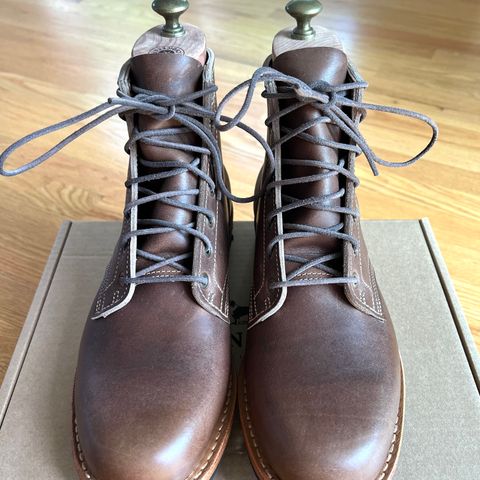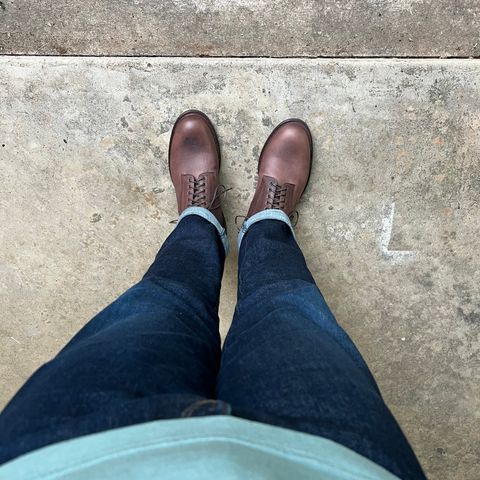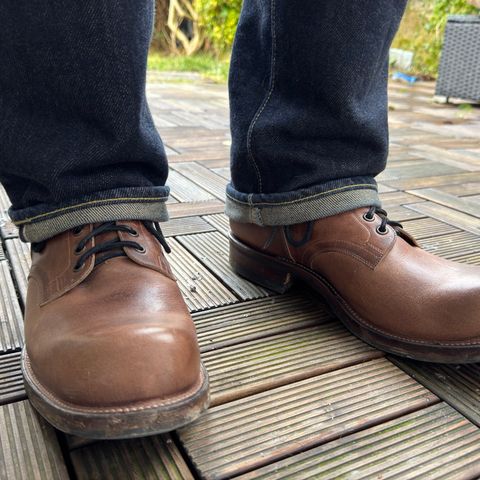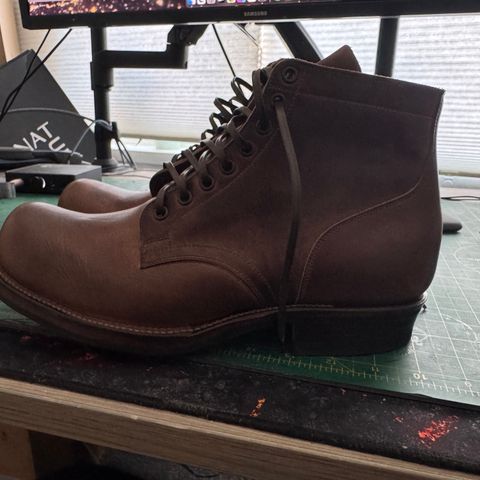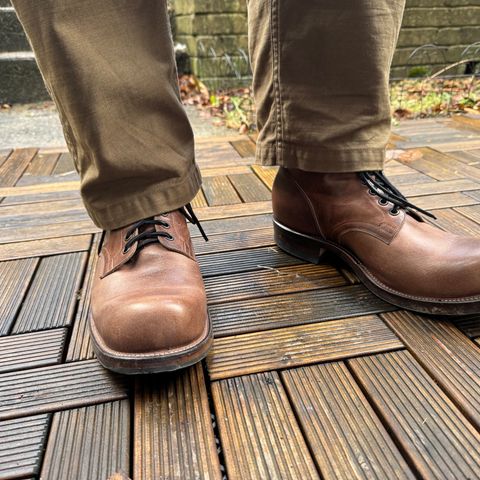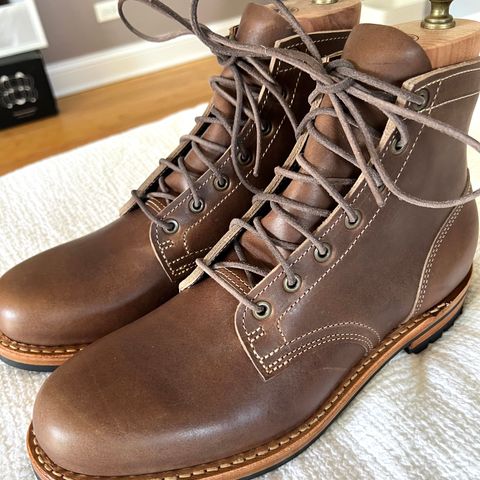About
Walnut Cypress is a rich brown variant of Horween Cypress leather that combines the deep, warm tones of walnut wood coloring with the distinctive characteristics of Horween's combination tanning process. Manufactured by the Horween Leather Company in Chicago, this leather offers an attractive medium-to-dark brown color that provides excellent versatility while maintaining all the performance and aging characteristics that define the Cypress leather line.
About
Walnut Cypress is a rich brown variant of Horween Cypress leather that combines the deep, warm tones of walnut wood coloring with the distinctive characteristics of Horween's combination tanning process. Manufactured by the Horween Leather Company in Chicago, this leather offers an attractive medium-to-dark brown color that provides excellent versatility while maintaining all the performance and aging characteristics that define the Cypress leather line.
The leather follows Horween's combination tanning methodology, beginning with chrome tanning for suppleness and durability, followed by a heavy vegetable retannage using different vegetable tannins than those employed in Chromexcel. The walnut coloration provides a sophisticated brown tone that appeals to those seeking a classic leather color with enhanced character development potential. This combination creates a leather that offers traditional aesthetic appeal while incorporating the modern performance advantages of combination tanning.
Walnut Cypress is particularly valued in heritage footwear applications where a rich brown color is desired alongside the durability and comfort characteristics of advanced tanning technology. The leather has gained recognition through its use by premium boot makers, with documented examples showing excellent aging potential and the development of distinctive character patterns through regular wear.
Manufacturing and Production
Walnut Cypress follows the same fundamental tanning process as other Cypress variants, with the walnut coloration achieved through careful dye application during the finishing stages to create the rich brown tone that characterizes this variant. The process begins with chrome tanning to establish a soft, supple, and durable foundation, followed by vegetable retanning using proprietary bark extracts that provide the structural characteristics and exceptional aging potential of the Cypress line.
The manufacturing process includes the characteristic fat liquoring stage where oils and waxes suspended in water are absorbed into the leather for enhanced depth and feel. Following this treatment, the leather undergoes finishing with stains and topical wax coats that are ironed into the surface, creating the smooth, tight grain with natural color variations and rich pull-up characteristics that distinguish Cypress leathers from other tanning methods.
The walnut color requires precise control during application to achieve the consistent, appealing brown tone while preserving the natural grain patterns and allowing for the color variation between individual hides that contributes to each piece's unique character. The mechanical drying process that concludes the tanning creates the compact structure that gives Cypress its substantial feel while maintaining the flexibility needed for comfortable footwear construction.
Characteristics
Walnut Cypress exhibits the fundamental characteristics of the Cypress leather line while presenting the rich, warm brown color profile that makes walnut-toned leather particularly appealing for heritage applications. The combination tanning process provides excellent pull-up properties where oils and waxes redistribute under mechanical stress, creating dynamic color variations that enhance the leather's visual appeal and demonstrate the quality of its construction.
The walnut coloration offers exceptional aging potential, with the ability to develop deeper, more complex brown tones through oxidation and wear that enhance the original color's richness. The vegetable retanning component enables the leather to evolve gracefully through use, developing attractive patina that adds character while maintaining structural integrity. Consumer documentation through platforms like the Patina Project demonstrates the leather's ability to develop distinctive wear patterns that reflect individual usage while maintaining its appealing appearance.
The leather maintains the substantial 6-ounce weight characteristic of Cypress leathers, providing the durability required for heritage boot construction while allowing for reasonable break-in periods. The combination tanning gives Walnut Cypress the character development potential of vegetable-tanned leather while avoiding the excessive stiffness that can make fully vegetable-tanned leathers uncomfortable during initial wear periods.
Applications
Walnut Cypress is extensively used in heritage footwear construction, with notable applications by companies such as Truman Boot Company, which has featured the leather in their Service Boot line. The rich brown color provides versatility that works well with both casual and more formal styling, making it suitable for boots intended for diverse wardrobe applications.
The leather's combination of attractive coloration and enhanced performance characteristics makes it particularly suitable for premium footwear where both immediate visual appeal and long-term character development are valued. Heritage boot makers appreciate the leather's ability to provide the classic brown leather aesthetic while offering the comfort and durability advantages of combination tanning technology.
Documentation through consumer platforms shows Walnut Cypress developing attractive aging patterns through regular wear, with the leather demonstrating its ability to evolve gracefully while maintaining structural integrity. The leather works effectively with various construction methods including Goodyear welting and stitchdown construction, providing the durability needed for resoleable footwear while ensuring comfort during extended wear periods.
Care and Maintenance
Walnut Cypress requires minimal maintenance due to its oil and wax content from the combination tanning and finishing processes. The rich brown color shows wear patterns and patina development in an attractive manner, with aging typically enhancing rather than detracting from the leather's appearance. The walnut tone provides an excellent foundation for patina development, showing character evolution in a visually appealing way.
Regular conditioning helps maintain the leather's flexibility and can enhance the patina development process for those who prefer more rapid character development. The pull-up characteristics allow minor scuffs and handling marks to integrate naturally into the leather's evolving appearance, while the oils and waxes help redistribute surface damage to minimize its visibility.
The walnut color may deepen gradually through exposure to light and handling, developing richer, more complex brown tones that enhance the leather's visual appeal over time. This natural aging process is part of the leather's intended character development and contributes to the unique personality that makes each piece distinctive to its owner, as documented in real-world aging examples from the heritage boot community.
References
"Horween Cypress Leather". The Tannery Row. Retrieved September 5, 2025.
"Charcoal & Walnut Cypress". Viberg. Retrieved September 5, 2025.
"Truman Service Boot in Horween Walnut Cypress". Patina Project. Retrieved September 5, 2025.
"Truman Service Boot Photos". Patina Project. Retrieved September 5, 2025.
"The Tanning Process: A look inside the Horween Leather Company". The Tannery Row. Retrieved September 5, 2025.
